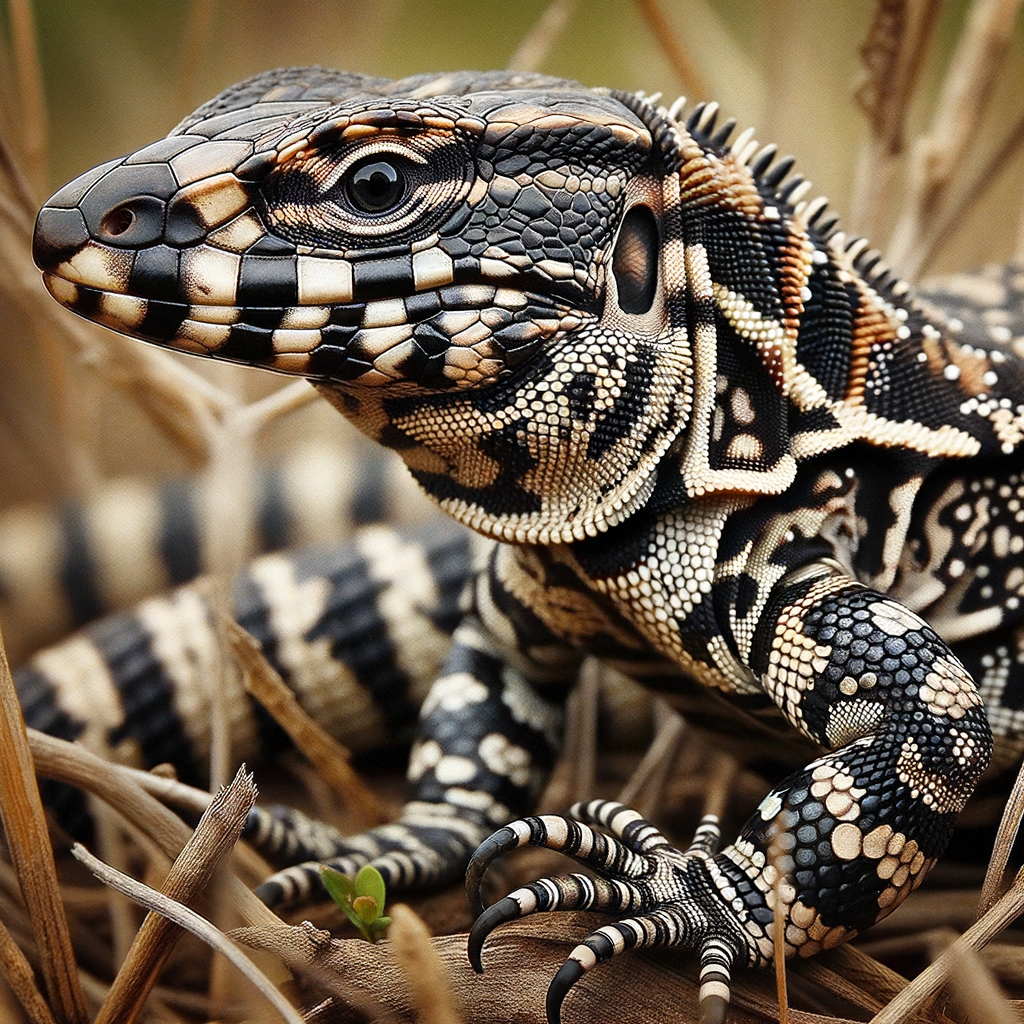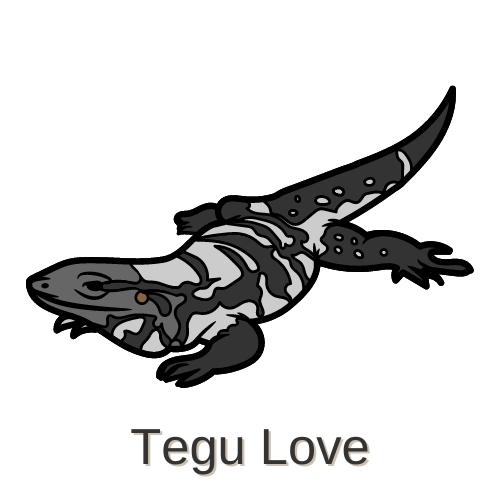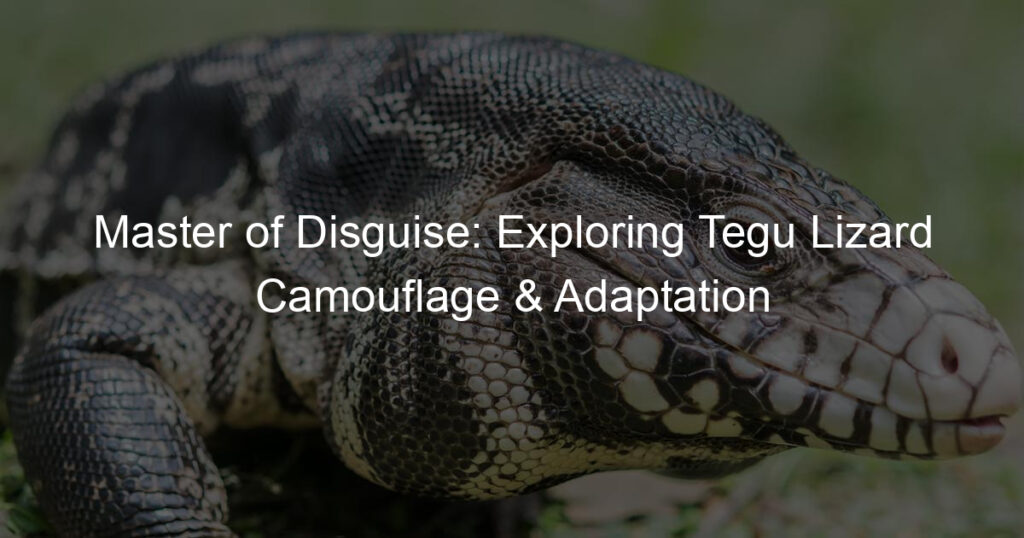
Introduction to Tegu Lizard Camouflage and Adaptation
When we think about the animal kingdom, one of the most fascinating aspects that come to mind is the ability of creatures to adapt to their environment. This ability is not just about surviving, but thriving in the face of challenges. In this article, we will explore the intriguing world of Tegu Lizards and their remarkable ability to camouflage and adapt.
-
-
Understanding the Concept of Camouflage and Adaptation
-
Camouflage and adaptation are two crucial survival strategies in the animal kingdom. Camouflage refers to the ability of an organism to blend in with its surroundings. It’s like a natural invisibility cloak that helps animals hide from predators or sneak up on prey. On the other hand, adaptation is the process by which an organism changes over time in response to its environment. These changes can be physical, like growing thicker fur in cold climates, or behavioral, like learning to hunt at night to avoid predators.
-
-
Introduction to Tegu Lizards
-
Now, let’s turn our attention to a specific creature that has mastered both camouflage and adaptation – the Tegu Lizard. Tegu Lizards are large, South American reptiles known for their distinctive black and white or gold coloration. They are incredibly adaptable and can thrive in a variety of environments, from rainforests to savannas.
One of the most fascinating aspects of Tegu Lizards is their ability to change their color according to the temperature. In cooler weather, they become darker to absorb more heat, and in warmer weather, they lighten their color to reflect heat. This is a perfect example of both camouflage and adaptation in action.
As we delve deeper into the world of Tegu Lizards, we will discover more about their behavior, characteristics, and survival strategies. So, stay tuned as we continue our exploration of these fascinating creatures and their incredible ability to camouflage and adapt.
The Art of Hide and Seek in Animals
Animals have developed an impressive array of techniques to stay hidden from predators and prey. This art of hide and seek, also known as camouflage, is a fascinating aspect of the animal kingdom. Let’s delve into the world of animal camouflage and explore the various techniques animals use to blend in with their surroundings.
Animal Camouflage Techniques
There are three main techniques animals use to camouflage themselves: color change, shape-shifting, and mimicry. Each of these techniques has its unique characteristics and advantages.
-
- Color Change
Many animals have the ability to change their color to match their environment. This is a common technique used by creatures like the chameleon and the cuttlefish. These animals have special cells in their skin that can change color in response to their surroundings. This allows them to blend in seamlessly with their environment, making them nearly invisible to predators and prey.
-
- Shape-shifting
Shape-shifting is another fascinating camouflage technique. Some animals can change their physical shape to resemble objects in their environment. For example, the leaf-tailed gecko can flatten its body to mimic the shape of a leaf, making it virtually undetectable in a forest setting.
-
- Mimicry
Mimicry is a technique where an animal imitates the appearance or behavior of another species to deceive predators or prey. The harmless milk snake, for example, mimics the coloration of the venomous coral snake to deter potential predators. This form of camouflage is a clever survival strategy that many animals use to their advantage.
In conclusion, the art of hide and seek in animals is a complex and fascinating subject. Whether it’s through color change, shape-shifting, or mimicry, animals have developed ingenious ways to stay hidden and survive in the wild. The next time you’re out in nature, take a moment to appreciate the incredible camouflage techniques of the animals around you.
Examples of Camouflage in Reptiles
Camouflage is a crucial survival strategy for many reptiles. By blending into their surroundings, these creatures can avoid predators and sneak up on prey. Let’s look at some examples of reptiles that are masters of disguise.
-
- Chameleons
Chameleons are perhaps the most famous examples of reptiles with the ability to change color. Their skin contains layers of special cells filled with pigments. By adjusting these cells, chameleons can match their surroundings, communicate with other chameleons, or even display their mood. This color-changing ability is not just about blending in, it’s a complex form of communication and survival.
-
- Tegu Lizards
Tegu lizards, native to South America, are also known for their camouflage abilities. These large lizards have a unique pattern of black and white stripes that allows them to blend into the shadows and light spots of their natural habitat. This helps them avoid predators and also makes them more successful hunters.
-
- Geckos
Geckos are another group of reptiles that use camouflage as a survival strategy. Many species of geckos have skin that matches the color and texture of the trees or rocks where they live. Some geckos can even change their color to match their environment, much like chameleons. This helps them hide from predators and catch their prey unawares.
These are just a few examples of the many reptiles that use camouflage to survive in the wild. By studying these creatures, we can learn more about the fascinating ways that animals adapt to their environments.
| Reptile | Camouflage Technique |
|---|---|
| Chameleons | Color change |
| Tegu Lizards | Pattern blending |
| Geckos | Color and texture matching |
Remember, the art of camouflage in reptiles is not just about survival, but also about communication and hunting. It’s a fascinating aspect of nature that continues to intrigue scientists and nature lovers alike.
Exploring Tegu Lizard Behavior
When it comes to the fascinating world of reptiles, the Tegu Lizard stands out with its unique behavior and survival tactics. One of the most intriguing aspects of this creature is its ability to camouflage. Let’s delve into this subject.
Tegu Lizard Camouflage
Camouflage is a survival skill that many animals, including the Tegu Lizard, use to blend in with their environment. This ability helps them hide from predators and also sneak up on their prey. The Tegu Lizard’s camouflage is primarily based on two factors: its color-changing abilities and its knack for environmental blending.
- Color changing abilities: Tegu Lizards are known for their impressive color-changing abilities. They can change their skin color to match their surroundings. This is not just a simple change from one color to another. The Tegu Lizard can alter the pattern and intensity of its colors, making it almost invisible in its natural habitat.
- Environmental blending: Apart from changing colors, Tegu Lizards are also experts at environmental blending. They use their surroundings to their advantage, hiding among leaves, rocks, and even in the soil. This ability to blend with the environment makes it difficult for predators to spot them.
- Case study: Tegu Lizard in the wild: A study of Tegu Lizards in their natural habitat revealed their remarkable camouflage abilities. When observed in the wild, these lizards were often undetectable until they moved. Their color-changing abilities, combined with their environmental blending, make them masters of disguise.
In conclusion, the Tegu Lizard’s ability to camouflage is a testament to its survival skills. It’s a fascinating example of how animals adapt to their environment to survive. In the next section, we will explore more about the Tegu Lizard’s adaptation abilities.
Tegu Lizard Adaptation
Adaptation is a key survival strategy for all living organisms, and the Tegu Lizard is no exception. This fascinating creature has developed unique adaptations to thrive in a variety of climates and diets. Let’s delve deeper into these adaptations and explore a case study of the Tegu Lizard in diverse habitats.
- Adaptation to Different Climates
The Tegu Lizard is a versatile creature, capable of surviving in a variety of climates. From the tropical rainforests to the arid deserts, these lizards have developed unique physiological and behavioral adaptations. For instance, in hotter climates, Tegu Lizards have the ability to regulate their body temperature by altering their color. Darker during the cold mornings to absorb heat and lighter during the hot afternoons to reflect it. In colder climates, they hibernate, slowing down their metabolism to conserve energy.
- Adaptation to Different Diets
Another remarkable adaptation of the Tegu Lizard is its dietary flexibility. These lizards are omnivorous, meaning they can eat both plant and animal matter. This allows them to adapt to a variety of food sources depending on their environment. They can consume fruits, vegetables, insects, small mammals, and even other reptiles. This dietary diversity is a key survival strategy, enabling them to thrive in different habitats where food sources may vary.
- Case Study: Tegu Lizard in Diverse Habitats
Let’s look at a case study of the Tegu Lizard in diverse habitats. In the rainforests of South America, Tegu Lizards utilize their color-changing abilities to blend in with the lush greenery and avoid predators. In contrast, in the deserts, they use their burrowing skills to escape the scorching heat and find food. This case study clearly demonstrates the Tegu Lizard’s remarkable ability to adapt to diverse habitats and climates.
In conclusion, the Tegu Lizard’s ability to adapt to different climates and diets is a testament to its resilience and survival skills. These adaptations not only allow it to survive but to thrive in a variety of environments, making it a fascinating subject of study for herpetologists and nature enthusiasts alike.
Adaptation in Lizards: A Comparative Study
Adaptation is a fascinating aspect of nature, allowing creatures to survive and thrive in their environments. In this section, we will delve into the world of lizards, specifically focusing on the Tegu lizard and its survival techniques.
Tegu Lizard Survival Techniques
The Tegu lizard, native to South America, has developed some unique survival techniques that allow it to thrive in its environment. These techniques primarily revolve around the use of camouflage.
-
- Use of camouflage for hunting
The Tegu lizard has a unique color pattern that allows it to blend seamlessly with its surroundings. This camouflage is not just for protection, but also for hunting. The lizard’s ability to blend in with its environment makes it almost invisible to its prey, giving it a significant advantage when hunting.
-
- Use of camouflage for protection
Camouflage also plays a vital role in the Tegu lizard’s defense strategy. By blending in with their surroundings, these lizards can effectively hide from predators. This survival technique has been so successful that it is now a common characteristic among many lizard species.
In conclusion, the Tegu lizard’s use of camouflage for hunting and protection is a prime example of nature’s adaptability. These survival techniques have allowed the species to thrive in its native environment and serve as a fascinating study in the field of reptile adaptation.
Adaptation Strategies in Other Reptiles
While Tegu lizards are fascinating creatures with their unique survival techniques, other reptiles also have their own set of adaptation strategies. Let’s explore the survival techniques of two other well-known reptiles: snakes and tortoises.
- Survival Techniques in Snakes
Snakes are known for their incredible survival skills. One of their primary techniques is their ability to blend into their surroundings. This is known as camouflage. Snakes use this technique to hide from predators and to hunt their prey. For example, the Gaboon viper, found in the rainforests and savannas of Africa, has a skin pattern that closely resembles the leaf litter on the forest floor, making it nearly invisible to both its prey and predators.
Another survival technique snakes use is their venom. Not all snakes have venom, but those that do use it to immobilize or kill their prey. The venom also serves as a defense mechanism against predators.
- Survival Techniques in Tortoises
Tortoises, on the other hand, have a different set of survival techniques. Their most notable adaptation is their hard shell, which they use for protection. When a tortoise senses danger, it pulls its head, tail, and legs into its shell, leaving the hard, protective shell as the only exposed part.
Another survival technique of tortoises is their ability to survive without food or water for long periods. Some species of tortoises can survive for up to a year without eating or drinking. This is especially useful in harsh environments where food and water are scarce.
| Reptile | Survival Technique |
|---|---|
| Snakes | Camouflage, Venom |
| Tortoises | Shell for Protection, Ability to Survive Without Food or Water |
In conclusion, each reptile species has its own unique set of survival techniques and adaptations that help it thrive in its specific environment. These survival strategies are the result of millions of years of evolution and are a testament to the incredible diversity and adaptability of life on Earth.
Tegu Lizard Characteristics and Survival
The Tegu Lizard, a fascinating creature, is known for its unique characteristics and survival strategies. Let’s delve into its physical attributes that play a significant role in its survival.
Physical Characteristics
Understanding the physical characteristics of the Tegu Lizard can help us appreciate its survival capabilities. These characteristics include its size and weight, as well as its color patterns.
-
- Size and Weight
The Tegu Lizard is a large reptile. Adult Tegus can grow up to 4.5 feet long, including their tail. They can weigh up to 15 pounds. This size and weight give them an advantage in their natural habitats, enabling them to defend themselves against predators and hunt for food efficiently.
-
- Color Patterns
The Tegu Lizard exhibits a variety of color patterns. These patterns not only make them visually striking but also serve a crucial survival function. The colors of a Tegu can range from black and white to gold, red, and even blue. These colors help them blend into their surroundings, making it harder for predators to spot them. This is a form of natural camouflage that aids in their survival.
In conclusion, the physical characteristics of the Tegu Lizard, particularly its size, weight, and color patterns, significantly contribute to its survival. These attributes equip the Tegu Lizard with the necessary tools to thrive in its natural habitat.
Behavioral Characteristics
Now, let’s dive into the behavioral characteristics of the Tegu Lizard. These behaviors are crucial for their survival and adaptation in their natural habitats. We will focus on two main behaviors: social behavior and hunting behavior.
-
- Social Behavior
The Tegu Lizard is known for its unique social behavior. Unlike many other lizards, Tegus are not solitary creatures. They often live in groups, showing a level of social interaction that is quite uncommon in the reptile world. This social behavior helps them in many ways. For instance, living in groups can provide protection against predators. It also allows them to share resources and information about food and shelter locations. This social behavior is a key aspect of their survival strategy.
-
- Hunting Behavior
When it comes to hunting, Tegu Lizards are quite efficient. They are omnivores, which means they eat both plants and other animals. Their diet includes fruits, insects, small mammals, and even other reptiles. Tegus have a keen sense of smell, which they use to locate their prey. Once they spot their target, they use their sharp teeth and strong jaws to capture and kill it. This hunting behavior is crucial for their survival, as it allows them to find and secure food in their natural habitats.
In conclusion, the Tegu Lizard’s behavioral characteristics, including its social behavior and hunting behavior, play a significant role in its survival and adaptation. These behaviors allow the Tegu to thrive in various environments, making it a fascinating creature to study.
Conclusion: Reptile Adaptation Strategies
As we reach the end of our exploration into the fascinating world of reptile adaptation strategies, it’s clear that these creatures are masters of survival. They have developed a range of unique and effective strategies to help them thrive in their environments. Let’s recap what we’ve learned, focusing on the Tegu lizard as a prime example.
-
- Summary of Tegu Lizard Camouflage and Adaptation
The Tegu lizard, native to South America, is a prime example of reptile adaptation at its finest. Its ability to change its skin color to match its surroundings is a powerful camouflage technique, helping it to avoid predators and sneak up on prey. In addition, the Tegu lizard’s behavioral adaptations, such as its burrowing habits and ability to regulate its body temperature, are key to its survival in a variety of climates and habitats.
-
- Key takeaways
There are several key points to remember about reptile adaptation strategies:
-
- Reptiles like the Tegu lizard use both physical and behavioral adaptations to survive and thrive in their environments.
- Camouflage is a common adaptation strategy, helping reptiles to avoid predators and catch prey.
- Behavioral adaptations, such as burrowing and body temperature regulation, are also crucial for survival.
- Understanding these adaptation strategies can help us to appreciate the complexity and resilience of these remarkable creatures.
In conclusion, the world of reptiles is a testament to the power of adaptation. These creatures, with their wide range of survival strategies, are a fascinating study in the resilience and ingenuity of life on Earth. As we continue to explore and understand these strategies, we can gain a deeper appreciation for the intricate balance of nature and the role each creature plays in the ecosystem.














